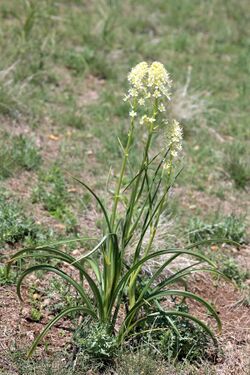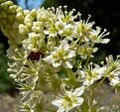Biology:Toxicoscordion venenosum
| Toxicoscordion venenosum | |
|---|---|

| |
| Toxicoscordion venenosum flowering Black Hills, South Dakota | |
| Scientific classification | |
| Kingdom: | Plantae |
| Clade: | Tracheophytes |
| Clade: | Angiosperms |
| Clade: | Monocots |
| Order: | Liliales |
| Family: | Melanthiaceae |
| Genus: | Toxicoscordion |
| Species: | T. venenosum
|
| Binomial name | |
| Toxicoscordion venenosum (S.Watson) Rydb.[1]
| |
| Synonyms[1] | |
| |
Toxicoscordion venenosum, with the common names death camas and meadow death camas, is a species of flowering plant in the genus Toxicoscordion, of the Melanthiaceae family. It is native to western North America from New Mexico to Saskatchewan and west to the Pacific Ocean.[2]
The plant is called alapíšaš in Sahaptin,[3] and nupqasaquⱡ ("nup-ka-sa-qush") in Ktunaxa.[3]
Description
Toxicoscordion venenosum grows up to 70 cm tall with long, basal, grass-like leaves. The bulbs are oval and look like onions but do not smell like edible onions of the genus Allium.[4]
The flowers are cream coloured or white and grow in pointed clusters, flowering between April and July. The flower clusters are a raceme (each cluster branches once along the main stalk), unlike its close relative Toxicoscordion paniculatum, in which the flowers are born in a panicle (doubly branched flower stalks). The flowers have three sepals and three petals.[5]
Varieties
Varieties include:[1]
- Toxicoscordion venenosum var. gramineum (Rydb.) Brasher
- Toxicoscordion venenosum var. venenosum – a variety or the solo current species classification[6][7]
Distribution
The plant is widespread across much of Western Canada, the Western United States, and northern Baja California (México).[1][8][9][10][11] It tends to grow in dry meadows and on dry hillsides as well as sagebrush slopes and montane forests.[8][12][13]
Toxicity
All parts of the plant are poisonous. It is dangerous for humans as well as livestock. Consumption of 2% to 6% of the body weight of the animal is likely to be fatal.[14][12] Along with other alkaloids, zygacine and other toxic esters of zygadenine are the primary neurotoxic alkaloids contributing to the plant's toxicity.[15]
The plant is visited by a specialist mining bee, Andrena astragali, which is possibly the only bee that can tolerate its toxins.[16] Others are fatally poisoned.[5]
References
- ↑ 1.0 1.1 1.2 1.3 "Toxicoscordion venenosum", World Checklist of Selected Plant Families, Royal Botanic Gardens, Kew, http://apps.kew.org/wcsp/namedetail.do?name_id=290133, retrieved 2012-04-22
- ↑ "Zigadenus venenosus S. Watson". United States Department of Agriculture. https://plants.usda.gov/home/plantProfile?symbol=ZIVE.
- ↑ 3.0 3.1 "FirstVoices- Ktunaxa words.". http://www.firstvoices.ca/en/Ktunaxa/word/1fedc88f7545ed2d/Black+Huckleberry. Retrieved 2012-07-07.
- ↑ Montana Plant Life: Meadow Death-camas Zigadenus venenosus
- ↑ 5.0 5.1 Taylor, Ronald J. (1994) (in en). Sagebrush Country: A Wildflower Sanctuary (rev. ed.). Missoula, MT: Mountain Press Pub. Co. pp. 80. ISBN 0-87842-280-3. OCLC 25708726. https://www.worldcat.org/oclc/25708726.
- ↑ Calflora Database: Toxicoscordion venenosum var. venenosum (variety of species)
- ↑ Jepson: Toxicoscordion venenosum var. venenosum (current species classification)
- ↑ 8.0 8.1 "Zigadenus venenosus". Flora of North America. efloras.org. http://www.efloras.org/florataxon.aspx?flora_id=1&taxon_id=242102105. Retrieved 2011-06-12.
- ↑ Biota of North America Program 2014 county distribution map
- ↑ Tropicos, specimen listing for Zigadenus venenosus S. Watson
- ↑ Caflora taxon report, University of California, Toxicoscordion venenosum (S. Watson) Rydb. Meadow deathcamas
- ↑ 12.0 12.1 "Meadow Death-camas". Montana Plant Life. http://montana.plant-life.org/species/zigaden_vene.htm. Retrieved 2011-06-12.
- ↑ Turner, Nancy J. (1997). Food Plants of Interior First Peoples. Victoria, British Columbia: University of British Columbia Press. ISBN 0774806060.
- ↑ Canadian Poisonous Plants Information System: Zigadenus venenosus
- ↑ Majak, Walter. "Soil moisture influences low larkspur and death camas alkaloid levels". Journal of Range Management Archives. https://journals.uair.arizona.edu/index.php/jrm/article/view/9397. Retrieved 6 November 2013.
- ↑ Wilson, Joseph S.; Messinger Carril, Olivia J (24 November 2015). The bees in your backyard : a guide to North America's bees. Princeton University Press. p. 78. ISBN 9780691160771.
External links
- Calflora Database: Toxicoscordion venenosum (Meadow deathcamas)
- Jepson Manual eFlora (TJM2) treatment of Toxicoscordion venenosum var. venenosum
- USDA Plants Profile for Zigadenus venenosus var. venenosus (meadow deathcamas)
- Lady Bird Johnson Wild Flower Center: Zigadenus venenosus (Meadow death camas, death camas)
- Turner Photographics, Wildflowers of the Pacific Northwest: Zigadenus venenosus (Meadow death camas)
- UC Photos gallery — Toxicoscordion venenosum
Wikidata ☰ Q3849177 entry
 |





